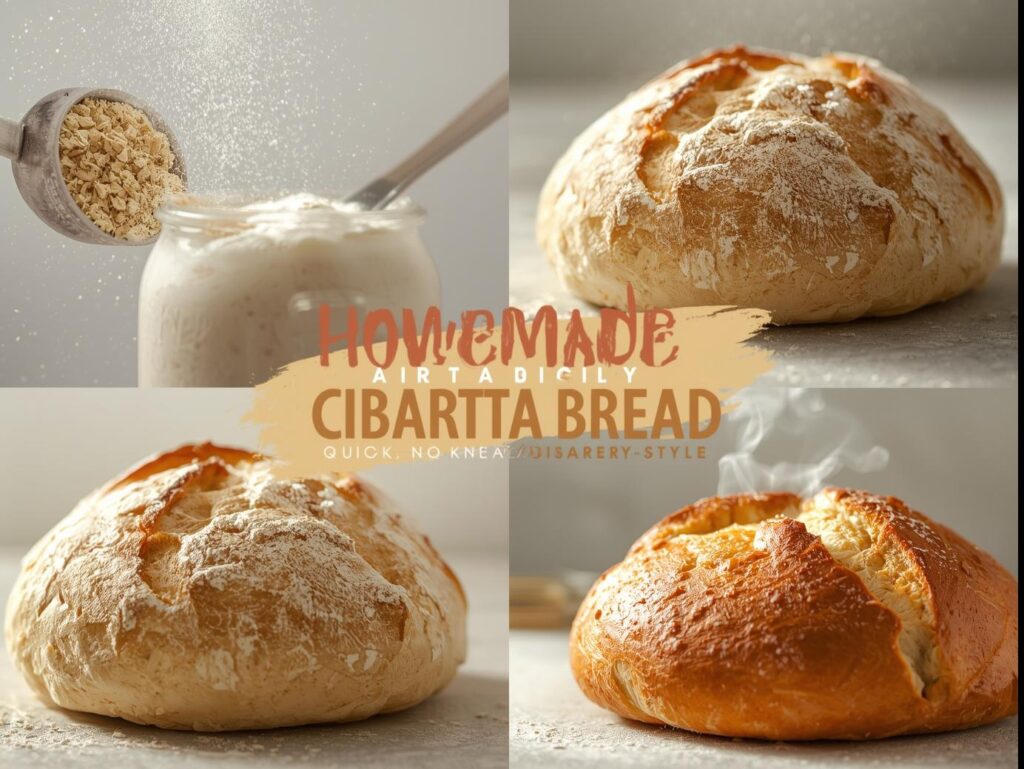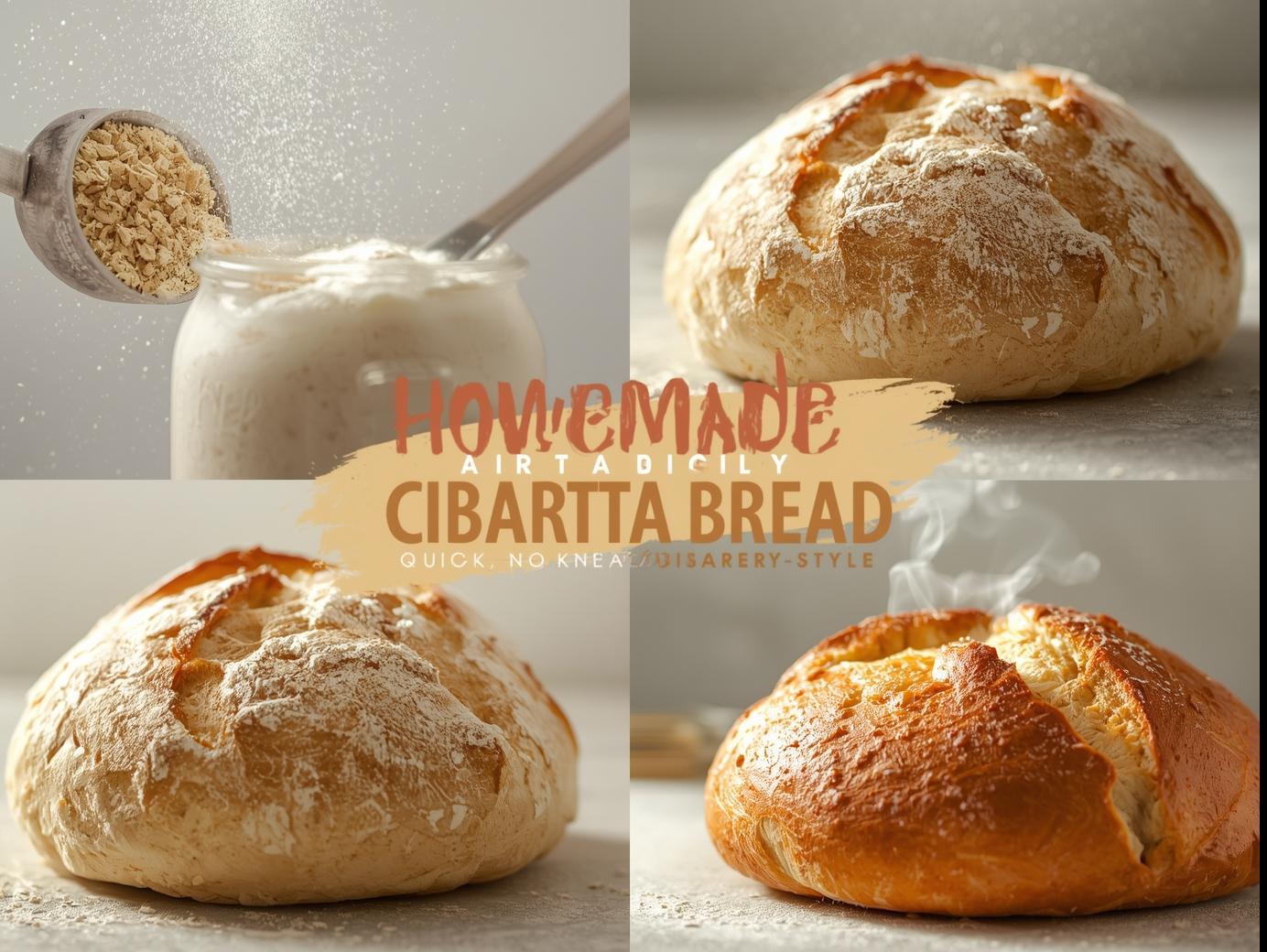Have you ever dreamed of pulling a loaf of golden, airy bread out of your own oven—but felt intimidated by the kneading, proofing, and complicated baking steps? You’re not alone. Many home bakers avoid bread-making because they think it takes professional skills or hours of labor. The good news? You don’t need fancy equipment or years of experience to make bakery-style bread at home.
In this guide, we’ll walk through a foolproof Homemade Ciabatta Bread – Quick, No Knead & Bakery-Style recipe that’s perfect for beginners. Whether you’re craving a rustic sandwich loaf, a side for soups, or just the joy of fresh-baked bread, this easy approach will give you incredible results without the hassle.
We’ll cover the benefits of no-knead bread, step-by-step instructions, expert tips, and even a quick comparison of tools you might need. By the end, you’ll feel confident enough to bake your first loaf tonight.
Why Choose No Knead Bread?
The no-knead method has revolutionized home baking. Instead of spending 20 minutes folding and pushing dough, you simply let time and hydration do the work.
Key Benefits:
- Effortless: Minimal hands-on time; the dough practically makes itself.
- Consistent Results: Achieve a soft, airy crumb with a crispy crust every time.
- Beginner-Friendly: Perfect for anyone who’s never baked bread before.
- Versatile: Works with ciabatta, artisan loaves, or even dinner rolls.
According to a survey by Bread Bakers Guild of America, nearly 68% of home bakers prefer no-knead methods because of their simplicity and success rate.
Step-by-Step Guide to Homemade Ciabatta Bread
Ingredients You’ll Need
- 4 cups all-purpose flour
- 1 ½ cups warm water
- 2 teaspoons salt
- ½ teaspoon instant yeast
- Olive oil for greasing
Instructions
- Mix the dough – In a large bowl, combine flour, yeast, salt, and warm water. Stir until a sticky dough forms.
- First rise – Cover with plastic wrap or a damp towel. Let it rest at room temperature for 12–18 hours.
- Shape the loaf – Gently transfer dough onto a floured surface. Divide into two loaves without punching out the air.
- Second rise – Place loaves on parchment paper, cover, and let rise for 1 hour.
- Bake – Preheat oven to 450°F (232°C). Bake for 25–30 minutes until golden brown and crusty.
Expert Tip: Professional baker Jim Lahey, who popularized no-knead bread, says, “Patience is your best ingredient. Let the dough ferment slowly—it rewards you with flavor and texture.”

Tools That Make Baking Easier
While you can bake ciabatta with just an oven and a bowl, a few tools make the process smoother.
| Tool | Purpose | Recommended For |
|---|---|---|
| Dutch Oven | Creates steam for a crispy crust | Beginner & pro bakers |
| Digital Kitchen Scale | Ensures accuracy in measurements | Precision baking |
| Bench Scraper | Helps handle sticky dough easily | Shaping ciabatta |
| Parchment Paper | Prevents sticking & easy cleanup | Any bread type |
| Cooling Rack | Maintains crisp crust after baking | Essential for results |
Tips for Perfect Bakery-Style Ciabatta
- High hydration = airy texture. Don’t be tempted to add too much flour to sticky dough.
- Steam matters. Bake inside a Dutch oven or place a tray of water in the oven to mimic bakery steam.
- Use bread flour if possible. It gives more structure and chewiness.
- Patience is key. Longer fermentation equals deeper flavor.
FAQs
1. What makes ciabatta different from regular bread?
Ciabatta has a higher hydration dough, which creates large air pockets and a chewy texture compared to sandwich bread.
2. Can I make no-knead ciabatta without a Dutch oven?
Yes, bake it on a baking stone or sheet with a tray of water in the oven to create steam.
3. How long does homemade ciabatta bread last?
It stays fresh for 2–3 days at room temperature. Freeze for up to 3 months.
4. Is ciabatta bread healthy?
While it’s not low-carb, ciabatta made at home has no preservatives, making it healthier than most store-bought options.
5. Can I use whole wheat flour instead of all-purpose?
Yes, but the bread will be denser. Mix half all-purpose and half whole wheat for the best balance.
6. Do I need to knead at all in this recipe?
No. Time and hydration replace kneading in this method.
7. What’s the best way to serve ciabatta bread?
It’s perfect for paninis, dipping in olive oil, or alongside soups and pasta.
Conclusion
Making Homemade Ciabatta Bread – Quick, No Knead & Bakery-Style isn’t just about baking—it’s about experiencing the joy of creating something rustic, warm, and delicious right in your kitchen. With just a few simple ingredients and a little patience, you can enjoy bakery-quality bread anytime.
Now it’s your turn! Try this recipe at home and share your experience in the comments below—what did you pair your ciabatta with?





Leave a Reply